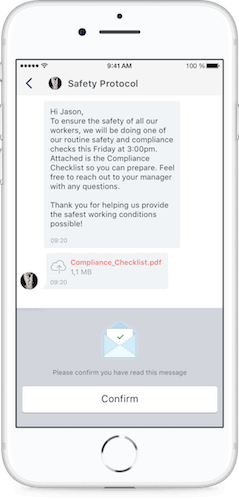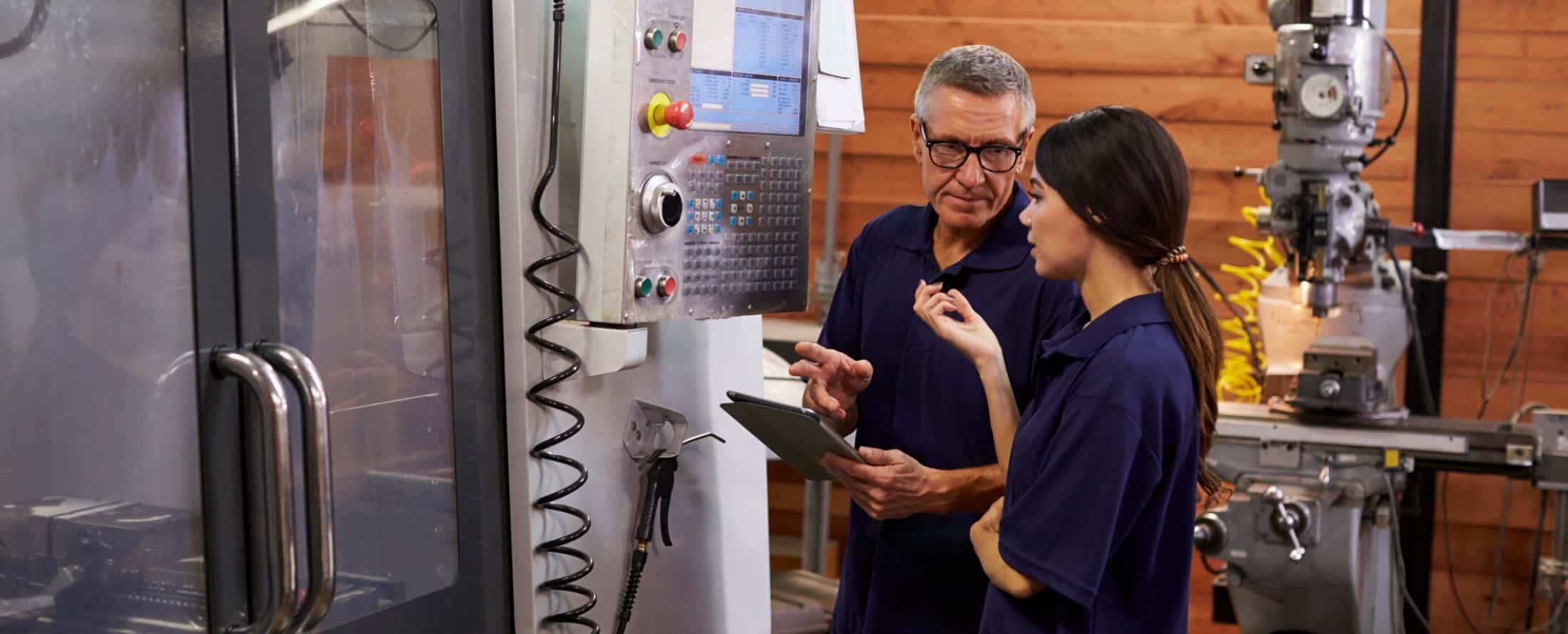In today’s workplace, employee communication doesn’t just take place between employees.
An equally important, if overlooked, component of communication in manufacturing involves the effective integration of digital technology. This is especially necessary for manufacturing environments where operations are increasingly handled by both human labor and machine technology.
To best understand why mobile employee technology is quickly making its way across factory floors around the world, let’s take a look at how the evolution of manufacturing technology got us to where we are today with Industry 4.0.
Manufacturing Technology: Industry 4.0 Is Here
It’s estimated that by 2025, over 75 billion manufacturing devices will be connected and communicating with each other, driving productivity up seven times what it is today.
Now, we aren’t at the stage where our manufacturing equipment is passing the Turing Test, but the arrival of the Internet of Things and smart machines have pushed us into the next stage of manufacturing technology.
For example, for something as simple as a torque wrench, smart machines can calibrate the amount of force to use on each part, thus decreasing errors and increasing efficiency.
This frees up employees on the floor to focus on higher-level tasks like planning, maintenance, and quality control.
From safety alerts to maintenance reports, effective, free-flowing employee communication is non-negotiable in the world of Industry 4.0.
That said, merging technical skills with soft skills like effective employee communication and collaboration is what can turn an ordinary manufacturer into a leading Lean Six Sigma organization.
The Case for Mobile Technology in Production Floor Communication
Manufacturing employees typically aren’t glued to their computers all day, but messaging technology can still improve communication on the floor. With mobile phone usage increasing, managers can utilize enterprise messaging apps and other mobile tech to gather feedback from their employees on the floor.
The employees manufacturing the product are closest to the action and have perspectives that managers would benefit from hearing. By facilitating production floor communication using mobile tech, managers can better oversee operations using key insights from frontline workers.
Just a few years ago, Ford realized that internal communications in their North American manufacturing facilities had calcified. Understanding the importance of employee communication, they developed a new system and incorporated it directly into their production system.
Joe Kimball, an HR manager at one of Ford’s plants, said of the changes:
“It has provided us with a system and a process so that we’re doing the same things everywhere and we’ve got a cadence laid out so that if you go from one plant to another you will see the same kinds of internal communications tools being used in a very deliberate way.”
If one of America’s oldest manufacturing companies can reinvent their internal communications, your manufacturing company can also embrace new technology.
Not yet convinced?
Let’s look at ten ways mobile technology can boost production floor communication and enhance overall efficiency.
Top 10 Ways Mobile Communication in Manufacturing Improves Employee Efficiency
Here’s how mobile-first communication makes manufacturing more efficient.
1. Provides Accessible Information to Everyone
Because manufacturing employees are on the production floor for the majority of the time, they don’t have the luxury to spend time at their desktop computers trying to find information that will help them do their job effectively. They more than likely won’t even have desktop computers to go to.
With mobile-first technology like an employee communication app, employees from every seat have access to relevant information just at their fingertips.
As AI and manufacturing technology systems become more mainstream, companies should view these tools as ways to boost employee productivity and efficiency. Broader access to critical information helps employees get their work done quickly – saving time, resources, and frustration across the board.
2. Utilizes Tools Employees Already Possess
81% of Americans own a smartphone, and with half of all frontline employees already using their phones on the job, it’s likely they’re already pulling out their devices to check on updates regularly. So, why wouldn’t companies want to leverage that established communication channel to connect with their employees?
3. Promotes Transparency with Management
In a survey of more than 1,500 small- to mid-sized manufacturing company CEOs, 82% said that speaking to their employees was challenging. In an industry where efficiency and growth are do-or-die propositions, it’s shocking that communication is the biggest obstacle.
“Manufacturers have focused so much on cost reduction that they’ve taken their eye off their people,” said Bill Flint, President of Flint Strategic Partners, a manufacturing consulting firm. He continues, “One of the best ways to tap into the collective wisdom of the production floor is to hold regular town-hall meetings, perhaps every quarter.”
4. Enhances Team Collaboration
It’s no secret that employee engagement still has a long way to go. According to a Gallup poll, only about 33% of employees are actively engaged at work across every industry group, and in manufacturing, that number is even lower at 25%.
For deskless employees, companies find it difficult to create a space that fosters team collaboration and engagement, primarily due to the outdated communication tools still in use.
Imagine trying to engage with your company’s mission or objectives by only seeing them written on a bulletin board you pass every day.
A mobile employee communication app with features like 1:1 and group messaging can enhance team collaboration and idea-sharing, leading to higher productivity on the manufacturing floor.
5. Makes Training Easy
Part of a positive employee experience is providing team members, both new and established, with the necessary training to get their jobs done safely and effectively.
With a digital workplace, manufacturing employees have access to tools like a documentation database, training videos, and helpful resources that get them up to speed as quickly as possible. In fact, it’s estimated to take up to 65 hours to onboard new employees with training information that allows them to reach a productive stage.
Having easily accessible training resources will accelerate that training time so employees can start contributing to the success of the company quicker.
6. Improves Employee Safety
Manufacturing is known to be a dangerous industry with on-the-job nonfatal incidents exceeding 400,000 in 2018.
Because of its incident history, health and safety have been critical factors for manufacturing companies long before the 2020 outbreak of COVID-19 and subsequent global shutdown. Nonetheless, the pandemic put a spotlight on organizations’ adaptability in crisis situations, making it apparent that having direct access to company news is imperative to keeping employees out of harm’s way.
Also, in using mobile employee technology for communication in manufacturing, companies can reduce safety costs by more than $40,000, by:
- Reducing workplace accidents with easy access to the latest health and safety guidelines, especially when it comes to a post-COVID environment
- Sharing necessary safety protocols with employees no matter their location
- Providing constant mobile access to guides and checklists to ensure procedures are followed

7. Saves Managers Time and Energy
With features like automated workflows and out-of-the-box integrations, employee apps that support communication in industry save managers and employees time and energy.
For example, part of the Beekeeper 2.0 evolution included digitized enhancements like shift schedules that make schedules easy to upload and digitally visible to employees at any time. This integration saves the employee from having to physically go to the factory to find out their shift schedule.
Also, the use of 1:1 in-app messaging saves managers time from having to send emails or taking away time to be in a meeting.
8. Promotes an Inclusive Workplace
Distributed workforces include and celebrate people from all walks of life. It promotes diversity of thought, race, gender, cultures, and languages, among others.
However, without modern employee technology, it can be difficult for businesses to connect with all of their employees in their native languages – causing a gap in company engagement for those employees.
With mobile apps like Beekeeper supporting production floor communications, employers can reach employees that are native speakers of over 100 different languages.
By promoting an inclusive workforce with inline translations, employers are also enhancing employee relationship building, improving overall safety, and fostering an environment that values information sharing across teams.
9. Bring Frontline Employees into The Conversation
Engaged employees are productive employees.
More importantly, frontline workers are the face of the business every day – so knowing their feedback and suggestions is critical in turning your organization into a well-oiled machine.
Using digital tools for communication in, companies can open communication channels for employees to submit their authentic feedback safely. With employee communication apps, you can easily send employee surveys or open group discussions – and then employ rich data and analytics features to understand the valuable insights of your employees better.
Pro tip: Give your survey questions some thought before sending out to employees. Not sure where to start? Learn everything you need to know about conducting an employee survey with Beekeeper
Keep in mind that feedback also begs action, and when employees see their suggestions put in place by the management team, they feel more connected with their workplace and inspired to keep doing their best jobs.
10. Ability to Communicate at the Same Speed as Everything Around Us
Manufacturing communication systems can, at times, seem many decades-old compared to the speed of communication that sits in our pockets.
When converting to a mobile communication strategy, the entire workforce can communicate at the same speed we’ve all come to expect in our daily lives.
For example, before adopting Beekeeper as its employee communication app, IRP Meat and Seafood Co.’s ordering process was easily disrupted by a slow-moving communication chain. The sales rep would receive and then relay information for an order to the in-house sales team that communicates with the processing team. If the processing team was out of stock of the ordered item, that communication would circle back around through the same channels.
Now, the company uses its Beekeeper’s group message streams to communicate an out-of-stock product to the sales rep immediately. Collectively, they’re improving customer service by having more direct and faster communication channels.
Communication in Industry in a Post-COVID Environment
As the manufacturing world continues to navigate our new environment, there are a few things that will stick around for the foreseeable future that can be best utilized with mobile technology.
- Having the ability to distribute information fast, particularly for health and safety protocol updates that can turn on a dime
- Finding ways to save time and money, of which, several features in employee communication apps are built to do just that
- Establishing direct communication channels for employees to connect with their co-workers and managers quickly, no matter their locations
- Adapting to customer needs and with a mobile employee app, teams can stay in constant communication to provide the absolute best service
- Ensuring enterprise-wide alignment with easy access to company news and information
Ready to get moving on a mobile technology solution for your manufacturing workforce? Beekeeper’s mobile platform is used by manufacturing companies around the world as the single point of contact for frontline workers. With manufacturing communication systems in one place, teams can improve productivity and quality control, reduce safety incidents, streamline SOPs, and become more cost-efficient in our ever-changing environment
Discover key trends in production floor communications in our white paper, “Manufacturing Industry Trends 2020.” Download your free copy today!
Most Frequently Asked Questions
As manufacturing employees aren’t glued to their computers all day, mobile technology is a great way for them to communicate.







